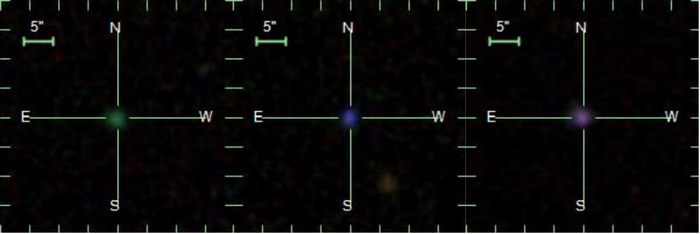Peas, blueberries and grapes – not every galaxy is like the Milky Way
Elliptical galaxies, spiral galaxies, barred spiral galaxies, you’ve probably heard of them. But did you know that there are types of galaxies named after green peas, blueberries, or purple grapes? When a group of amateurs within the “Galaxy Zoo,” a project conducted by citizen scientists, classified galaxies observed by the Sloan Digital Sky Survey (SDSS) by color and morphology, they found 251 very special galaxies that didn’t easily fit into the known galaxy types. These galaxies, which looked round and dense like beans and appeared green on digital images, were later named “Green Pea Galaxies.”
A team of researchers from Chinese astronomers has now found hundreds more compact galaxies using the Chinese telescope LAMOST DR9, which includes a large number of Green Pea, Blueberry and Purple Grape galaxies. This is the largest group of new compact galaxies discovered at one time to date. The researchers conducted a systematic study of the star formation rate, metallicity, and environment of these galaxies, providing a new perspective for understanding the formation and evolution of galaxies in the early universe.
The Green Pea galaxies are about 1.5 to 5 billion light-years away and are less than 1/10 the size and 1/100 the mass of the Milky Way. Strong emission lines give them a bright green color, which also means that new stars are forming intensively in them. The Green Pea galaxies have a high rate of star formation – about ten times that of the Milky Way – doubling their mass in a few hundred million years. They are also known for their low metallicity and were likely widespread in the early universe. The study of Green Pea galaxies therefore opens a new window for understanding the formation and evolution of galaxies and star formation in the early universe.
Due to the different positions of the emission lines in the photometric bands, typical compact galaxies include “Blueberry galaxies” and “Purple Grape galaxies,” which appear blue and purple in pseudocolor images, respectively. Blueberry galaxies are closest to us and are more compact than Green Pea galaxies, at less than 1/3000 the size of the Milky Way. Purple Grape galaxies, on the other hand, are located between the Blueberry and Green Pea galaxies, or even beyond the Green Pea galaxies. The Purple Grape galaxies have a similar radius to the Green Pea galaxies and a mass of less than 1/500 of the Milky Way.
All of these galaxies are small and faint, making them very difficult to observe and limiting their observational capabilities. Prior to this work, the largest sample of compact galaxies with spectral information included only about 800 members. Based on the LAMOST data, this study discovered 1,417 new compact galaxies, nearly twice as many as previously known. These include 739 Green Pea galaxies, 270 Blueberry galaxies, and 388 Purple Grape galaxies – in other words, a veritable “extragalactic fruit and vegetable garden.” The mass of these newly discovered compact galaxies ranges from 310,000 to 10 billion solar masses, with the most distant galaxies about 9 billion light-years away.
